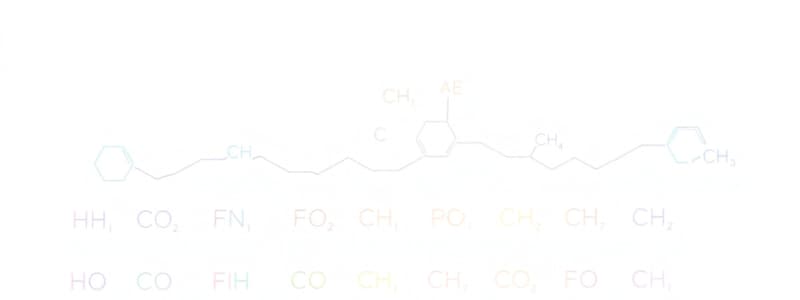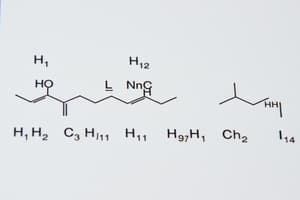Podcast
Questions and Answers
What is the primary purpose of IUPAC nomenclature in chemistry?
What is the primary purpose of IUPAC nomenclature in chemistry?
- To provide common names for organic compounds based on their historical discovery.
- To assign ambiguous names to chemical structures, allowing for multiple interpretations.
- To name organic compounds after their discoverers.
- To establish a standardized and unambiguous naming system for chemical compounds. (correct)
Which of the following steps is NOT a basic principle of IUPAC nomenclature?
Which of the following steps is NOT a basic principle of IUPAC nomenclature?
- Identifying and naming all functional groups in the molecule.
- Numbering the parent chain to give the principal functional group the lowest possible number.
- Identifying the shortest carbon chain in the molecule. (correct)
- Listing substituents alphabetically when assembling the name.
What is the general molecular formula for alkanes?
What is the general molecular formula for alkanes?
- $C_nH_{2n+2}$ (correct)
- $C_nH_{2n-2}$
- $C_nH_{2n}$
- $C_nH_{2n-4}$
In IUPAC nomenclature, what suffix is used to denote an alkane?
In IUPAC nomenclature, what suffix is used to denote an alkane?
What is the correct IUPAC name for $CH_3CH_2CH_2CH_3$?
What is the correct IUPAC name for $CH_3CH_2CH_2CH_3$?
When naming branched alkanes, how are alkyl groups attached to the parent chain indicated in the IUPAC name?
When naming branched alkanes, how are alkyl groups attached to the parent chain indicated in the IUPAC name?
What is the general molecular formula of an alkene?
What is the general molecular formula of an alkene?
What suffix is used in IUPAC nomenclature to indicate the presence of a carbon-carbon triple bond?
What suffix is used in IUPAC nomenclature to indicate the presence of a carbon-carbon triple bond?
A compound is named 3-methyl-2-pentanol. Which functional group is present in this compound?
A compound is named 3-methyl-2-pentanol. Which functional group is present in this compound?
Which of the following is the correct IUPAC name for the compound $CH_3CH_2CH_2COCH_3$?
Which of the following is the correct IUPAC name for the compound $CH_3CH_2CH_2COCH_3$?
What is the correct way to name $(CH_3)_2CHNH_2$ according to IUPAC nomenclature?
What is the correct way to name $(CH_3)_2CHNH_2$ according to IUPAC nomenclature?
A molecule contains both an alcohol and a ketone group. Which functional group will determine the suffix of the IUPAC name?
A molecule contains both an alcohol and a ketone group. Which functional group will determine the suffix of the IUPAC name?
Which prefix is used to indicate two identical substituents on a parent chain in IUPAC nomenclature?
Which prefix is used to indicate two identical substituents on a parent chain in IUPAC nomenclature?
How are substituents on a cyclic alkane numbered when there are multiple substituents present?
How are substituents on a cyclic alkane numbered when there are multiple substituents present?
What is the general formula for naming esters?
What is the general formula for naming esters?
A compound is found to contain a carbon-carbon double bond and an alcohol group. What suffix would be included in the name?
A compound is found to contain a carbon-carbon double bond and an alcohol group. What suffix would be included in the name?
Which of the following functional groups has the highest priority when naming a compound with multiple functional groups?
Which of the following functional groups has the highest priority when naming a compound with multiple functional groups?
How are secondary and tertiary amines named when using the substituent naming approach?
How are secondary and tertiary amines named when using the substituent naming approach?
Flashcards
IUPAC Nomenclature
IUPAC Nomenclature
A systematic method of naming organic chemical compounds.
Parent Chain
Parent Chain
The longest continuous carbon chain in a molecule, forming the base name.
Substituent
Substituent
An atom or group of atoms attached to the parent chain.
Alkanes
Alkanes
Signup and view all the flashcards
Alkyl Groups
Alkyl Groups
Signup and view all the flashcards
Alkenes
Alkenes
Signup and view all the flashcards
Alkynes
Alkynes
Signup and view all the flashcards
Prefixes (di-, tri-, tetra-)
Prefixes (di-, tri-, tetra-)
Signup and view all the flashcards
Alcohol
Alcohol
Signup and view all the flashcards
Ether
Ether
Signup and view all the flashcards
Halide
Halide
Signup and view all the flashcards
Aldehyde
Aldehyde
Signup and view all the flashcards
Ketone
Ketone
Signup and view all the flashcards
Carboxylic Acid
Carboxylic Acid
Signup and view all the flashcards
Ester
Ester
Signup and view all the flashcards
Amine
Amine
Signup and view all the flashcards
Amide
Amide
Signup and view all the flashcards
Stereoisomers
Stereoisomers
Signup and view all the flashcards
Study Notes
- IUPAC nomenclature constitutes a systematic approach for naming organic chemical compounds, as sanctioned by the International Union of Pure and Applied Chemistry (IUPAC).
- The goal is to create a standardized naming system, thus avoiding confusion caused by common names.
- Employing IUPAC nomenclature ensures that every chemical structure possesses an unambiguous and unique name.
- IUPAC nomenclature serves as a universal language for chemists, facilitating clear communication across research, industry, and educational sectors.
Basic Principles
- Identify the Parent Chain: Locate the longest continuous carbon chain within the molecule, which becomes the base name for the compound.
- Identify the Functional Groups: Pinpoint the principal functional group, as it dictates the suffix to be used in the naming.
- Number the Parent Chain: Assign numbers to the carbon atoms present in the parent chain to ensure the principal functional group (or substituent) receives the lowest possible number.
- Identify and Number Substituents: Name and assign numbers to all substituent groups that are attached to the parent chain; these substituents are designated with prefixes.
- Assemble the Name: Integrate the substituent names, the parent chain name, and the functional group suffix into a unified name, listing substituents alphabetically.
Alkanes
- Alkanes represent hydrocarbons that contain only single bonds, characterized by the general formula CₙH₂ₙ₊₂.
- Alkane names universally conclude with the suffix "-ane."
- For straight-chain alkanes, prefixes denote the number of carbon atoms, including methane (1), ethane (2), propane (3), butane (4), pentane (5), hexane (6), heptane (7), octane (8), nonane (9), and decane (10).
- Branched alkanes feature alkyl groups that are affixed to the parent chain.
- Alkyl groups are named by substituting the "-ane" suffix of the corresponding alkane with "-yl," exemplified by methyl (CH₃), ethyl (CH₂CH₃), and propyl (CH₂CH₂CH₃).
- A number indicates the position of the alkyl group on the parent chain.
- If there are two or more identical alkyl groups, prefixes like "di-," "tri-," "tetra-," are employed to specify their count, with each receiving a numerical designation.
Alkenes and Alkynes
- Alkenes encompass hydrocarbons that possess one or more carbon-carbon double bonds (C=C), following the general formula CₙH₂ₙ.
- Alkynes include hydrocarbons that contain one or more carbon-carbon triple bonds (C≡C), adhering to the general formula CₙH₂ₙ₋₂.
- Alkene names conclude with the suffix "-ene," while alkyne names end with "-yne."
- The position of the double or triple bond gets indicated by a number placed before the suffix.
- In instances of multiple double or triple bonds, prefixes such as "di-" and "tri-" are added before the "-ene" or "-yne" suffix.
Alcohol, Ethers, and Halides
- Alcohols are characterized by the presence of a hydroxyl (-OH) group and are named using the suffix "-ol."
- A number preceding the suffix denotes the location of the hydroxyl group.
- Ethers are defined by an oxygen atom that is bonded to two alkyl or aryl groups (R-O-R').
- Ethers are named by first identifying the two alkyl/aryl groups that are attached to the oxygen atom, enlisting them alphabetically, and subsequently adding "ether."
- As an alternative, the larger alkyl group can function as the parent chain, wherein the -OR group is named as an alkoxy substituent.
- Halides are marked by a halogen atom (F, Cl, Br, I) that is bonded to either an alkyl or an aryl group.
- The naming of halides involves attaching the prefix "fluoro-," "chloro-," "bromo-," or "iodo-" to the name of the parent alkane.
Aldehydes and Ketones
- Aldehydes are constituted by a carbonyl group (C=O) that is bonded to at least one hydrogen atom.
- The carbonyl group is invariably located at the terminus of the carbon chain (position 1).
- Aldehyde names are identified by the suffix "-al."
- Ketones are defined by a carbonyl group (C=O) that is bonded to two alkyl or aryl groups.
- The suffix "-one" characterizes ketone names.
- The location of the carbonyl group gets specified by a number that precedes the suffix, unless present on the 2nd carbon.
Carboxylic Acids and Esters
- Carboxylic acids are known for containing a carboxyl group (-COOH).
- Carboxylic acid names are distinguished by the suffix "-oic acid."
- Esters represent carboxylic acid derivatives where the carboxyl group's hydrogen atom is substituted by an alkyl or aryl group.
- Esters are named as alkyl or aryl alkanoates.
- The alkyl or aryl group that attaches to the oxygen atom is named first, followed by the carboxylic acid part, and the suffix "-oic acid" is altered to "-oate."
Amines and Amides
- Amines have a nitrogen atom that bonds to one, two, or three alkyl or aryl groups.
- The suffix "-amine" is used in naming amines, or they can be referred to as amino substituents.
- In the case of secondary and tertiary amines, the alkyl or aryl groups that attach to the nitrogen atom get indicated via the prefix "N-," succeeded by the group's name.
- Amides feature a nitrogen atom that is bonded to a carbonyl group (C=O).
- The suffix "-amide" denotes amide names.
- When the nitrogen atom is substituted, the substituents get indicated by the prefix "N-", followed by the group's name.
Cyclic Compounds
- Cyclic alkanes are named using the prefix "cyclo-" added to the name of the alkane that shares an equivalent number of carbon atoms.
- Numbering of substituted cycloalkanes is performed to allocate the lowest potential numbers to the substituents.
- If there is only one substituent, it is automatically assigned to position 1.
Multiple Functional Groups
- When a compound harbors multiple functional groups, one is selected as the primary functional group, which in turn determines the name's suffix.
- The remaining functional groups are denoted as substituents with the use of prefixes.
- Generally, the principal functional group is selected based on a priority table, prioritizing functional groups.
- The priority order is as follows: Carboxylic acids > Esters > Aldehydes > Ketones > Alcohols > Amines > Ethers > Alkenes/Alkynes > Alkanes > Halides.
Stereochemistry
- Stereoisomers constitute isomers exhibiting identical connectivity but vary in their atomic arrangement in space.
- Stereochemical descriptors get appended to the IUPAC name to define the configuration of stereocenters.
- Common stereochemical descriptors include R/S for chiral centers, and E/Z or cis/trans for alkenes alongside cyclic compounds.
IUPAC Naming Steps Summary
- Locate the longest carbon chain encompassing the principal functional group.
- Number the carbon chain to assign the lowest possible number to the principal functional group.
- Identify and name all substituents present.
- Arrange the substituents alphabetically, incorporating appropriate prefixes (di-, tri-, etc.).
- Assemble the substituent names, parent chain name, and functional group suffix, and encompass stereochemical descriptors if applicable.
Studying That Suits You
Use AI to generate personalized quizzes and flashcards to suit your learning preferences.




